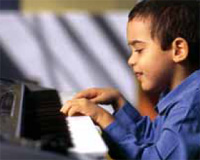Born on April 10, 2000, Sebastian seemed to be in good shape. He was 19.5 inches long, weighed 3.5 pounds and spent only four hours on a ventilator—pretty impressive for a baby born 11 weeks premature. But that was only the first test for young Sebastian.
Before their son’s inaugural homecoming, new parents Esther and Carlos were told Sebastian needed to see a neurologist. During their visit, Sebastian was diagnosed with a severe case of cerebral palsy, a condition that causes difficulty with muscle control. In Sebastian’s case, it would make it nearly impossible to pass key milestones like chewing solid foods and walking.
“A specialist in the community said my son would never be normal,” Esther recalls, “so I never went to him again.”
Instead, the Hialeah resident took Sebastian to a rehabilitation center in Miami, where she eventually learned of a procedure offered at Nicklaus Children's Hospital, formerly Miami Children's Hospital, that would change Sebastian’s life forever.
Moving Forward
Only a little later than his peers, Sebastian learned to walk using a walker. As he walked, Sebastian’s legs moved in a scissor-like motion, causing his body to droop close to the floor. After a lot of research, encouragement from Sebastian’s physical therapist, and a meeting with Glenn Morrison, MD, pediatric neurosurgeon on staff at Nicklaus Children's, Esther decided selective dorsal rhizotomy could benefit her 4-year-old son.
“Before I met Dr. Morrison, I was very nervous about the procedure,” Esther admits. “However, the way the doctor explained it and his calm, friendly manner helped me relax, and I realized Sebastian would be in good hands.”
Proceeding to a Better Life
During selective dorsal rhizotomy, a one- to two-inch incision is made in the lower back. Through this hole, the surgeon can view the sensory nerve fibers running from the muscles to the spinal cord. Those nerve fibers responsible for creating the muscle tightness are cut, relieving tension in the affected limbs. The incision is then closed with special surgical glue.
“Sebastian was a good candidate to see positive results from the procedure as he didn’t have an excessive amount of spasticity,” says Dr. Morrison. “For maximum benefit, patients have to undergo intense physical therapy afterwards. Sebastian’s mom made sure her son did that, and Sebastian has reaped the benefits as a result.”
 A Bright Future
A Bright Future
Since undergoing his operation last summer at the ripe age of 4, Sebastian has started walking again—now with proper posture—and has hopes of one day running with his 18-month-old sister, Rebecca, without his walker. He is fluent in Spanish and English, has a love of the arts, attends Miami Springs Elementary and has started eating solid foods.
“There is not a word in the English language to show how grateful I am for the surgery Sebastian underwent,” Esther says. “I want to say ‘Thank you, thank you, thank you,’ to all the staff at Nicklaus Children's who helped my son. It’s the best thing that could ever have happened to him.”